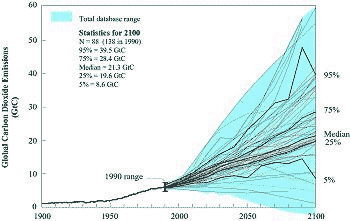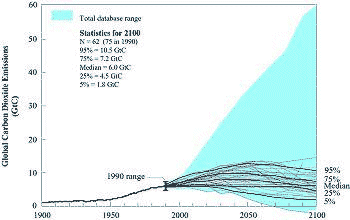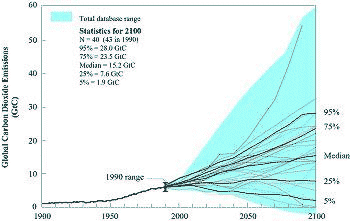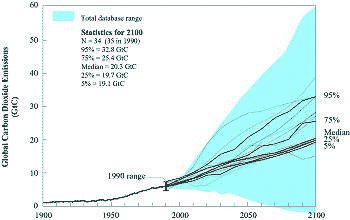|
2.4.1. Carbon Dioxide Emissions Ranges (continued)
Some additional information about the range of future emissions can be obtained
by examining the results from detailed analyses (see, e.g., Alcamo et al., 1996,
1998) conducted by Nordhaus and Yohe (1983), Edmonds et al. (1986), de Vries
et al. (1994), and Manne and Richels (1994). These analyses confirm that the
range is very large. The analysis of Edmonds et al. (1986) shows a range of
87 to 2 GtC by the year 2070 for the 95th and 5th percentiles, respectively;
the range is from 27 to 4 GtC for the 75th and 25th percentiles. Nordhaus and
Yohe (1983) estimated the range to be from 55 to 7 GtC for the 95th and 5th
percentiles, and from 27 to 12 GtC for the 75th and 25th percentiles, respectively.
In contrast, de Vries et al. (1994) estimated a fundamentally smaller
range of 24 to 11 GtC by 2050 for the 95th and 5th percentiles, respectively,
but they standardized some of the scenario assumptions, such as population and
economic growth, relative to a base case.
The SRES team also applied the criteria presented in Section
2.2 to identify intervention scenarios from among the CO2
emissions scenarios in the database. Of the 190 scenarios that reported CO2
emissions through the year 2100, 62 were classified as intervention scenarios
and 88 as non-intervention scenarios. For 40 scenarios the information available
was insufficient to determine whether or not they included any climate policies.
These are referred to as non-classified scenarios. The statistics for these
three scenario samples are given in Table 2-2. The medians
for these samples are also shown in Figures 2-1c to 2-1f.
The analysis indicates that many of the 88 non-intervention scenarios are emulations
of IS92 scenarios, and many of these are emulations of IS92a. For example, 42
of the 88 non-intervention scenarios were produced by EMF-14, of which 25 are
based on IS92a.
Figure 2-1c shows spaghetti curves for the non-intervention
scenarios found in Table 2-2. In the year 2100 these scenarios
cover almost the same range (1.2 GtC to 59.4 GtC) as does the entire sample
of 190 scenarios (-2.1 GtC to 59.4 GtC). The sample of non-intervention scenarios
includes some that have very low emissions, which suggests that emissions can
be low even in the absence of explicit climate intervention policies. However,
the non-intervention sample also has a higher median than the total sample -
21 GtC in 2100 compared with the 15.7 GtC median found in the total sample.
The lower median of the total sample may result from downward pressure exerted
by the inclusion of some intervention scenarios in the total sample. However,
it could also result from the influence of IS92a-like scenarios (upward pressure)
in the non-intervention sample (see also Figure 2-1f).
|

Figure 2-1c: Global energy-related
and industrial CO2 emissions for 138 non-intervention scenarios identified
from the SRES database. Historical development and future scenarios
are shown as absolute values in GtC. Median (50th), 5th, 25th, 75th, and 95th percentiles of the frequency distribution are shown.
The statistics associated with scenarios from the literature do not
imply probability of occurrence (e.g., the frequency distribution of
the scenarios may be influenced by the use of IS92a as a reference for
many subsequent studies). Again, the emissions paths indicate a wide
range of future emissions. The actual coverage of CO2 emissions sources
may vary across the 138 scenarios from the database included in the
figure. The scenario samples used vary across the time steps (for 1990
138 scenarios; for 2100 88 scenarios were analyzed). Data sources: Morita
and Lee, 1998; Nakicenovic et al., 1998a.
|
| Table 2-2: Database minimum,
maximum, and median CO2 emissions levels in the year 2100 (in GtC). Data
source: Morita and Lee, 1998. |
|
| |
Number of scenarios
|
Minimum
|
Maximum
|
Median
|
|
| Intervention scenarios |
62
|
-2.1
|
14.4
|
6.0
|
| Non-intervention scenarios |
88
|
1.2
|
59.4
|
21.3
|
| Non-classified cenarios |
40
|
-0.4
|
32.4
|
15.2
|
| |
|
|
|
|
| Total sample |
190
|
-2.1
|
59.4
|
15.7
|
|
Figure 2-1d likewise depicts spaghetti curves
for the intervention scenarios. The entire range for the intervention scenarios
is small compared to those of the no policy scenarios and the total set of scenarios.
In 2100 the maximum (14.4 GtC) and the median (6 GtC) of this sample are significantly
lower than maximum and median values of the full and non-intervention sets.
|

Figure 2-1d: Global energy-related
and industrial CO2 emissions for 75 intervention scenarios identified
from the SRES database. Historical development and future scenarios
are shown as absolute values in GtC. Median (50th), 5th, 25th, 75th
and 95th percentiles of the frequency distribution are shown. The statistics
associated with scenarios from the literature do not imply probability
of occurrence. The emissions paths for intervention scenarios show a
more limited range of future emissions than do those for the non-intervention
scenarios (see Figure 2-1c). The actual
coverage of CO2 emissions sources may vary across the 75 scenarios from
the database included in the figure. The scenario samples used vary
across the time steps (for 1990 75 scenarios; for 2100 62 scenarios
were analyzed). Data sources: Morita and Lee, 1998; Nakicenovic et
al.,1998a.
|
Figure 2-1e shows the range for scenarios that
could not be classified into these two groups because of insufficient information
in the database. The range of scenarios in this category is similar to that
of the total sample in that it is very broad. The median of this set in 2100
is also similar to that of the total sample (15.7 GtC) and follows a similar
trajectory.
|

Figure 2-1e: Global energy-related
and industrial CO2 emissions for 43 scenarios that could not be classified
as intervention or non-intervention scenarios from the SRES database.
Historical development and future scenarios are shown as absolute values
in GtC. Median (50th), 5th, 25th, 75th, and 95th percentiles
of the frequency distribution are shown. The statistics associated with
scenarios from the literature do not imply probability of occurrence.
The emissions paths for the "non-classified" scenarios indicate a wide
range of future emissions. The actual coverage of CO2 emissions sources
may vary across the 43 scenarios from the database included in the figure.
The scenario samples used vary across the time steps (for 1990 43 scenarios;
for 2100 40 scenarios were analyzed). Data sources: Morita and Lee,
1998; Nakicenovic et al.,1998a.
|
Finally, the IS92a scenario (Leggett et al., 1992; Pepper et al.,
1992) appears to have influenced subsequent emissions scenarios in the literature.
The median population, gross world product, and primary energy consumption trends
in many scenarios in the literature track very closely the developments in the
IS92a scenario (Morita and Lee, 1998). This is because IS92a constituted a reference
baseline that was emulated by different modeling groups in a number of scenario
evaluation and comparison activities. Figure 2-1f shows
the set of 35 IS92a-like scenarios that could be classified from the set of
non-intervention scenarios. As these scenarios appear to emulate IS92a, they
show little variation around the median of 20.3 GtC, which is about the emission
level in that scenario (20.4 GtC) in 2100.
|

Figure 2-1f: Global energy-related
and industrial CO2 emissions for 35 "IS92a-like" scenarios identified
from the set of non-intervention scenarios included in the SRES database.
Historical development and future scenarios are shown as absolute values
in GtC. Median (50th), 5th, 25th, 75th and 95th percentiles of the frequency
distribution are shown. The statistics associated with scenarios from
the literature do not imply probability of occurrence. The actual coverage
of CO2 emissions sources may vary across the 35 scenarios from the database
included in the figure. The scenario samples used vary across the time
steps (for 1990 35 scenarios; for 2100 34 scenarios were analyzed).
Data sources: Morita and Lee, 1998; Nakicenovic et al., 1998a.
|
The analyses in the following sections focus on the total set of scenarios
in the database only. The distinction between intervention and non-intervention
scenarios applies only to analyses of CO2 emissions.
|